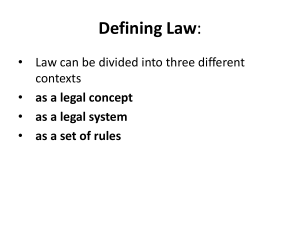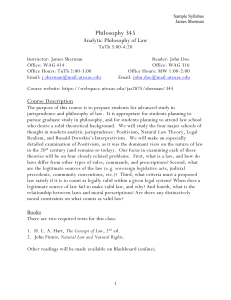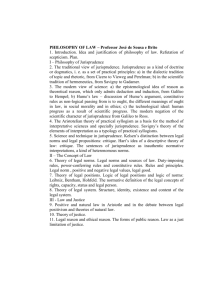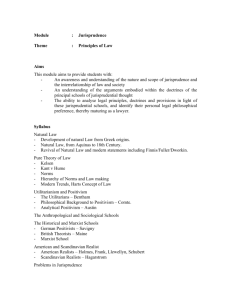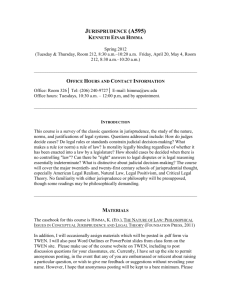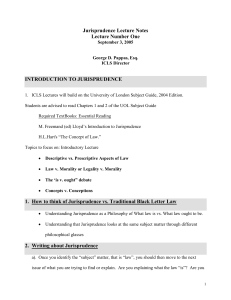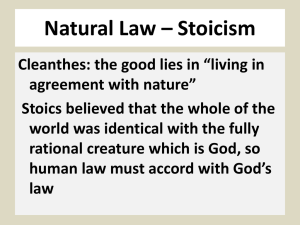Social Theory of Law, lecture 2
advertisement
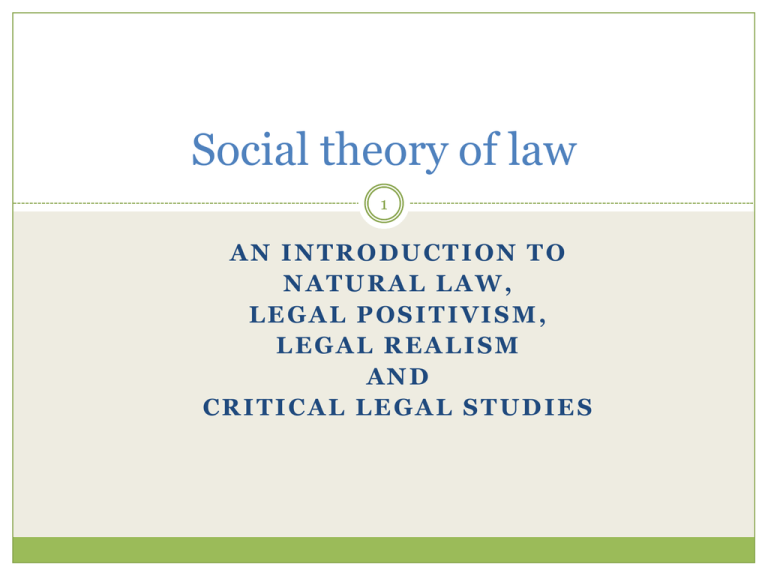
Social theory of law 1 AN INTRODUCTION TO NATURAL LAW, LEGAL POSITIVISM, LEGAL REALISM AND CRITICAL LEGAL STUDIES Philosophical Theories 2 Philosophical theory in law is called Jurisprudence We will look at: What is jurisprudence? Some of the schools of thought in Western jurisprudence What is jurisprudence? 3 “It is the theory and philosophy of law” “A subdivision of philosophy of law dealing with ethical questions concerning the administration of justice within a society” “The philosophy of law” – Hames and Ekern Introduction to Law, p4. Note: The word "philosophy" comes from the Greek φιλοσοφία (philosophia), which literally means "love of wisdom" What is the philosophy of law all about? 4 Legal philosophers ask questions such as “what is law”, “why do we need law”, “what should the law be?” Jurisprudence (the philosophy of law) looks at the origins of law, the meaning of law and the relationship between law and morality Scholars who are interested in these questions are referred to by a variety of different names, for example: Legal philosophers Legal theorists Scholars of jurisprudence Four primary schools of thought 5 Western jurisprudence/philosophy of law has 4 main schools of thought: 1. Natural law 2. Legal Positivism 3. Legal Realism - A reaction to Legal Formalism (so, what is Legal Formalism?) Critical Legal Studies 4. 1. 2. 3. Feminist Legal Theory Critical Race Theory Other offshoots: Critical Race Feminism, LatCrit (Latino critical race studies), AsianCrti (Asian-American critical race studies) etc Natural Law - I 6 What is it? The theory that law reflects moral and unchangeable laws of nature – Hames & Ekern, p.4 Natural law is the idea that: there are rational objective limits to the power of legislative rulers the foundations of law are accessible through human reason, and it is from these laws of nature that human created laws gain whatever force they have. Shiner, "Philosophy of Law", Cambridge Dictionary of Philosophy Natural Law II – general ideas 7 Natural law theorists believe that there are eternal and unchangeable laws in nature and that man-made laws must correspond to them as closely as possible. Since it comes from nature, natural law must be universal It exists because we are human: its inherent in human beings It is said to be universal, eternal & unchangeable If a man-made law does not reflect the moral and unchangeable laws of nature, then the law is not really a law at all and it doesn’t need to be obeyed Historically, natural law has a close relationship with morality and with the intentions of God but not all natural law theorists believed in God Natural law theorists would say: “an unjust law is not law at all and we don’t need to obey it” Natural Law III 8 Examples of philosophers who adhered to natural law included: Aristotle (the “father” of natural law”) Socrates St Thomas Aquinas Aristotle in the Rhetoric: aside from the "particular" laws that each people has set up for itself, there is a "common" law that is according to nature. St Thomas Aquinas: Natural law is the human "participation" in the eternal law and it is discovered by reason Natural Law IV 9 We will look mainly at two famous Natural Law theorists, one classic, one modern: Cicero – classic natural law theorist John Finnis – modern natural law theorist We may also briefly consider natural law and Islam e.g. Ibn Rushd (in English, known as ‘Averroes’) who is famous for translating and explaining Aristotle’s writing. Averroes/Ibn Rushd thought that humans know by nature of the wrongness of killing and stealing. Humans know of the 5 ‘maqasid’ or ‘higher intents’ or goals: religion, life, lineage, intellect and property Legal Positivism I 10 What is it? The validity of law is not related to morality. If a law is properly formed, then it is a valid law. Hames and Ekern, p.4 Legal Positivism: there is no necessary connection between law and morality the force of law comes from some basic social facts although positivists differ on what those facts are. Soper, "Legal Positivism", Cambridge Dictionary of Philosophy Legal Positivism II 11 Law is law because it is “posited”, that is, laws are validly made in accordance with socially accepted rules. Provided a law is properly formed, in accordance with the rules recognized in the society concerned, it is a valid law, regardless of whether it is just Consider examples: Apartheid South Africa Nazi Germany Is a “bad” law still a law? Legal Positivism III 12 Famous Legal Positivists include: Jeremy Bentham John Austin H.L.A. Hart Austin: Austin's answer to the question "what is law?”= "commands, backed by threat of sanctions, from a sovereign, to whom people have a habit of obedience” Hart: As the chair of jurisprudence at Oxford University, Hart argued that law is a 'system of rules'. Legal Positivism IV - Hart 13 H.L.A. Hart – 1907-1992 Most famous book: The Concept of Law, 1961 Primary rules (rules of conduct) and secondary rules (rules addressed to officials to administer primary rules). Secondary rules are divided into rules of adjudication (to resolve legal disputes), rules of change (allowing laws to be varied) and the rule of recognition (allowing laws to be identified as valid).* The "rule of recognition“ = a customary practice of the officials (especially judges) that identifies certain acts and decisions as sources of law. Other important legal positivists** Legal realism 14 What is it? Legal realists believe that laws are created by men and are therefore subject to the pitfalls created by men Hames & Ekern, p.5 Legal realism argues that the real world practice of law is what determines what law is; the law has the force that it does because of what legislators, judges, and executives do with it. Legal Realism II 15 Skeptical in tone, Legal Realism holds that the law should be understood and determined by the actual practices of courts, law offices, and police stations, rather than as the rules and doctrines set forth in statutes or learned treatises. All law is made by human beings and, thus, is subject to human foibles, frailties and imperfections. Examples of Legal Realists: Justice Oliver Wendell Holmes, Jr., Karl Llewellyn Jerome Frank Critical Legal Studies 16 What is it? A younger theory of jurisprudence Developed since the 1970s Takes a negative view of law Says law is contradictory and can be best analyzed as an expression of the policy goals of the dominant social group Critical Legal Studies (CLS) originated out of American Legal Realism No coherent theory but some frequent themes Critical Legal Studies (CLS) II 17 Some common themes: legal materials (such as statutes and case law) do not completely determine the outcome of legal disputes all "law is politics” tends to serve the interests of the wealthy and the powerful by protecting them against the demands of the poor and the subaltern (women, ethnic minorities, the working class, indigenous peoples, the disabled, homosexuals etc.) for greater justice CLS continues as a diverse collection of schools of thought and social movements. The CLS community is an extremely broad group with clusters of critical theorists at law schools Conclusion 18 Legal theorists are interested in the “big” questions about law, morality and society This is a complicated area of study and a specialized area of study Scholars are seeking answers to questions that perhaps cannot be properly answered or answered absolutely You need to have a general understanding that this body of law exists and of the importance of it You need to be able to : 1) Understand what scholars have written 2) Form your own opinion about those views 3) Apply them by using examples



